Garden Designers Roundtable: Shades of Limelight on the Garden Stage (& Other One-Color Gardens)
In Breakfast at Tiffany’s Holly Golightly cautions, “There are certain shades of limelight that can wreck a girl’s complexion.” Maybe so, but not a garden’s complexion. For proof, I give you these images of a limelight-colored border from the Biltmore House gardens in Asheville, North Carolina, which I recently visited. Using varying shades of just one color—in this case, greenish white—can give you an easy yet incredible result for a garden border or even an entire garden.
Vita Sackville-West popularized the concept of the one-color garden with her famous white garden at Sissinghurst. Moonlight gardens, designed for evening enjoyment, rely on the same strategy, using white or pale yellow plants that glow in the light of the moon. Darker-hued leaves and flowers seem to disappear at night, so these are left out of the design. (Choose scented, night-blooming plants like moonflower vine to add another dimension to the moonlight garden.)
If you garden like me, you plant any color that appeals to you—blues mingle with reds, greens with yellows. You may make pairings of analagous or complementary colors, or you may just let ‘er rip. Hey, whatever makes you happy. But if you have enough discipline, you might enjoy making a garden using multiple shades of just one color.
It’s best not to rely only on flower color for this technique to work. It’s equally important to incorporate foliage plants that fit your chosen color scheme. Foliage, after all, carries the garden through the quieter flowering periods and adds texture and season-long form.
As with any garden, it’s good design to use varying shapes. The Biltmore border contrasts the vertical, strappy leaves of variegated cane with the fluffy globes and broad leaves of hydrangea.
You might also consider whether any shades of your chosen color clash with each other. For example, among white flowers and variegated leaves you’ll find creamy, warm whites; snowy, bright whites; cool, bluish whites; and greenish yellow whites. But I wouldn’t overthink it. Paying more attention to form and texture will create a good result, and if two shades happen to clash you can always separate them next season.
Since seeing the limelight Biltmore border, I want to try using a single color in my garden. I adore color too much and am too much of a plant collector to make my whole garden like this, but I love the idea of a monochromatic border or garden room, especially in such delicious shades of greenish white. Or maybe a silvery blue garden, like Lotusland’s blue garden! Central Texas is hospitable to plenty of drought-tolerant, silvery blue plants—Yucca rostrata ‘Sapphire Skies’, ‘Whale’s Tongue’ agave, ‘Blue Ice’ Arizona cypress, silver Mediterranean fan palm, gopher plant (Euphorbia rigida), ‘Bath’s Pink’ dianthus, Wheeler’s sotol, paleleaf yucca (Y. pallida), and bush germander, to name a few—so this would be an easy one-color garden to try in our region.
When you enter a garden built around various shades of one color, it makes a big impact. And choosing single-color plants will really open your eyes to the colors of foliage, which you may not have paid as much attention to before.
When you have time, please check out the posts of my fellow Roundtablers and our special guest, Margaret Roach, to see how they’ve interpreted the topic of Shade. Links can be found at Garden Designers Roundtable and below:
Margaret Roach : A Way To Garden : Hudson Valley, NY
Andrew Keys : Garden Smackdown : Boston, MA
Christina Salwitz : Personal Garden Coach : Renton, WA
Debbie Roberts : A Garden of Possibilities : Stamford, CT
Douglas Owens-Pike : Energyscapes : Minneapolis, MN
Genevieve Schmidt : North Coast Gardening : Arcata, CA
Lesley Hegarty & Robert Webber : Hegarty Webber Partnership : Bristol, UK
Susan Cohan : Miss Rumphius’ Rules : Chatham, NJ
All material © 2006-2011 by Pam Penick for Digging. Unauthorized reproduction prohibited.


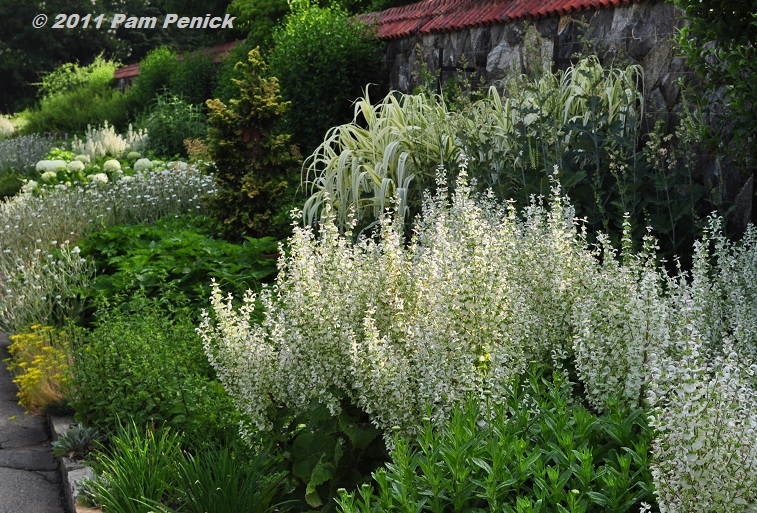
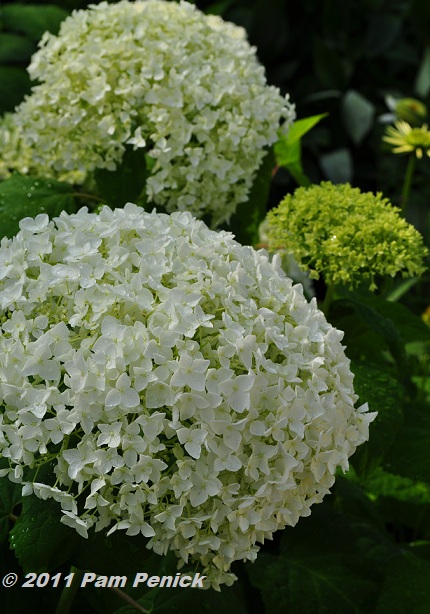
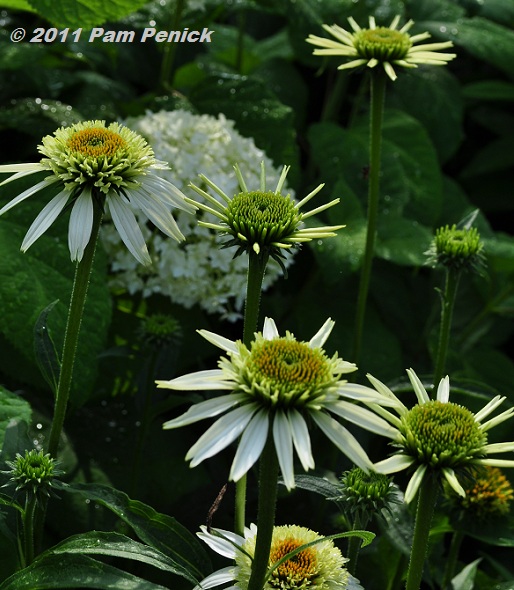
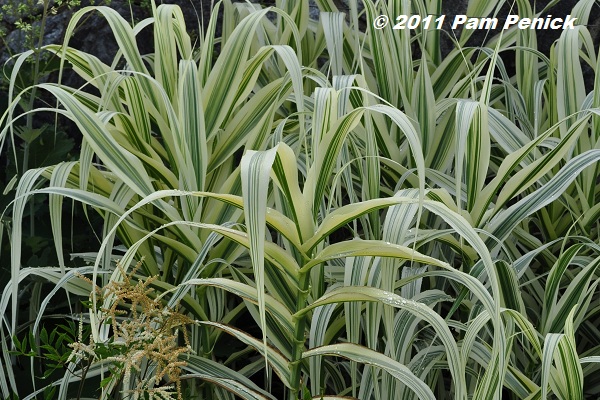
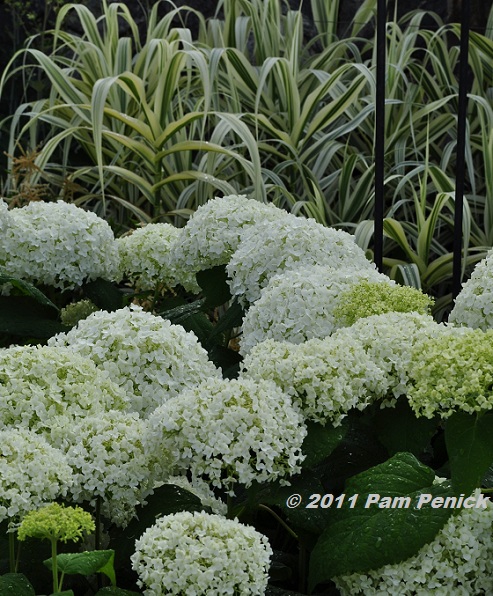
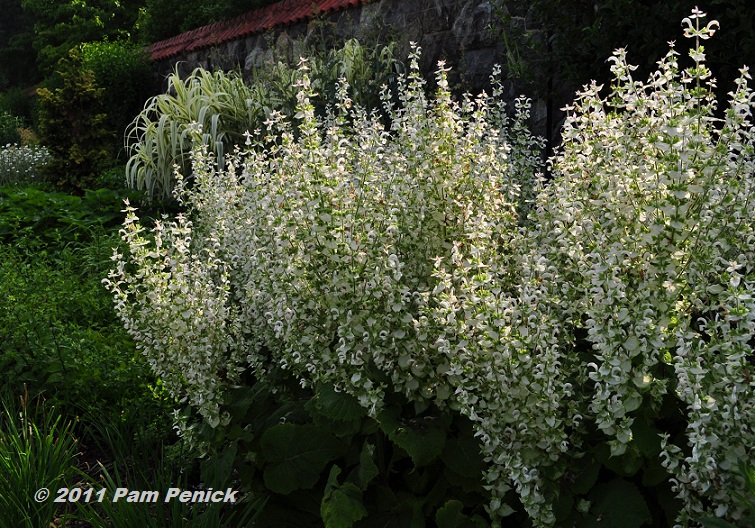
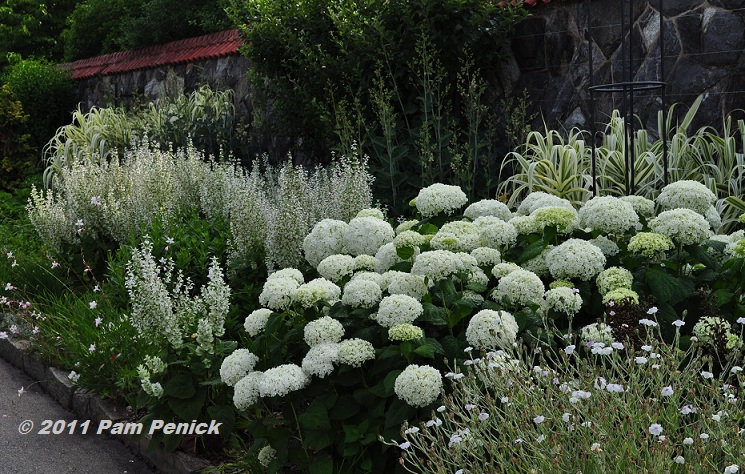
Pam, I’ll add to your list my fave silver plants: artemesia, silver ponyfoot, lambs ears, japanese painted fern and santolina. With your list and mine, I think you’ve just helped me figure out one of my problem areas! I love this post, and want to go back to the Biltmore. Until then, I’ll see it vicariously through you. thanks.
Thanks for the additions, Robin. Those are all faves of mine too except Japanese painted fern, which I haven’t tried yet. —Pam
That is something truly special. I love the combination of whites in this garden bed. I’m trying to create a small white garden bed myself, but have had mixed success with it. I’m definitely going to have another go.
A white garden seems so fresh and cool for summer, doesn’t it? Good luck with yours! —Pam
Pam, Your photos really give a sense of how serene that white garden must be. Like you, I enjoy color too much and simply don’t have the discipline needed to only use shades of one color in my own garden. I love the contrast of the variegated cane with the smooth hydrangea, one of my all-time favorite shrubs. Your take on shade is very thought-provoking.
Thanks, Debbie. I nearly went in a different direction for the Roundtable’s shade theme—writing about man-made shade structures. But in editing my Biltmore photos this tack occurred to me and I went with it. —Pam
This is beautiful! This might be interesting to try! I think a monochromatic garden would be a great idea for a foundation planting in front of a house- could really help set off the house!
That sounds like an intriguing idea, Melissa. Have fun with it! —Pam
I love the Garden Designers Roundtable – and the Shade designs are especially appealing to me. I have no shade. Oh well, I have roses.
A sun garden with roses gives you the perfect opportunity to create a little shade with rose arbors, doesn’t it? I bet you have one or two. Thanks for the kind comment about the Roundtable, too! —Pam
Hmmm, I like that greenish-white light you describe in those plantings. Sticking to one color or light tone can be rewarding, once I forced myself to do it at my own place. Educating clients in this is not always so easy; your examples should help even though NC is a radically different place than my laser beam sun. Sometimes, the light is soft here – mornings like today or under a full moon. That’s when it’s comfortable, too.
And agreed – reliance on fleeting flowering is a fail! Thanks for the inspiration.
I find myself drawn to cool foliage over and over, David, so I think it would be pretty easy to make a silvery blue garden here in central Texas. In fact, I often have to make myself add different colors for contrast. It would be fun, I think, to let the one-color garden rip sometime. —Pam
I was thinking hmmmm, luscious, yummy, exquisite, elegant and then you mentioned Biltmore and I swooned. Gorgeous photos Pam- you rocked the SHADE post!!! I will be mailing your crown out to you soon. 🙂
Oh boy! Thanks for the kind words, Christina, and the enthusiasm! I really loved this border and would have nosed around in it even longer if I’d not already exhausted my kids’ patience with taking garden photos. 😉 —Pam
Thanks for sharing these beautiful photos of a truly inspiring garden! These plantings show a great amount of discipline as well as plant/design mastery. Beautiful!
Thanks, Jocelyn! I’m glad you enjoyed it. —Pam
Oh, I LOVE shades of white and silver in the shade! Really brightens it up, and it’s so elegant. Great pics, as usual, PP!
Thanks, Jenny. I love white in the shade too. This border happened to be in full sun, but it must be wonderful in the early morning and early evening. —Pam
Pam I am NUTS about these photos! I’m putting the Biltmore House on my must-see garden list.
Thanks, Susan! I’ve been posting about Biltmore’s gardens all week, if you care to look back through my recent posts. Yep, one of these days you should visit. I hear that the Garden Bloggers Fling may be held in Asheville next year… —Pam
White on white makes the shade even cooler. No pun intended. There is drama in the absence of color. Thanks for sharing these images. They made me think.
My pleasure, Susan. Thanks for your thoughtful comment. —Pam
Gorgeous, frosty cool. The monochromatic colors really throw into relief the contrast in forms. I think those white fluffy spires might be Salvia sclarea var. turkestanica, a plant that I will one day get to like my garden.
Thanks for the possible ID, Denise. And great point about how a single-color garden puts more focus on the plant forms. —Pam
I love an all white garden, especially at night. The Biltmore garden is lovely.
Yes, that’s when a white garden really shines, so to speak. Thanks for your thoughts, Donna. —Pam
I think using a monochromatic color scheme is just as dramatic as a mix of colors, maybe even more so. I love the idea of a silvery blue border, agaves, santolina and artemsia has always been my favorite plants anyway. Great photos! You inspire me on every post. 🙂
Thanks so much, Kim! I’m glad to know you find inspiration here. I get so much from reading other blogs too. —Pam
LOVED your interpretation of SHADE! You R so right about the form and texture being the thing in these monochrome borders – that is precisely what your pics prove. Some people in this country sneer at colour borders now. But they are such an immediate wow! I am sure we can have it all really.
Thanks so much for this
Best
R
Yes, why can’t we have it all, Robert? That’s the spirit! Thanks for your kind words too. —Pam
The gardens at the Biltmore have long been one of our favorite vacation destinations. I also love color too much to do an entire garden in this theme, but a few years ago we put in an all white shade garden along a neglected side of the house and it has been a surprisingly popular bed. A lot of these same plantings cohabit there, and it really is stunning, especially at dusk. But I hadn’t thought of lime colored blossoms there – what a terrific idea for a pop of non-color!
That’s a great place to experiment with an all-white garden, Cathy. And yes, a few lime green accents in there would look wonderful, I bet. —Pam
Pam, I’m so taken with the beautiful scenes you show! I love that variegated cane, and is that a sage towards the bottom? I adore it! I’m like you – not enough discipline; too much of a plant collector to do this in my own garden – but I love the soothing tones.
Could that bottom-right plant be a white rose campion? Yes, I love the variegated cane too! —Pam
You and I are so often on the same page, Pam. Just this past week I’ve been noticing I’m favoring more and more the creamy white and soft lime colors. Not the bright whites, but the creams. Your gorgeous photos have given me a lot to think about – thanks!
I like the creams better than the cool whites too, Rebecca. They are easier to work with, and yummy also! —Pam
Love this, so cool and refreshing, and the Breakfast at Tiffany’s quote is so apt.
I agree, Sarah—the creamy whites and cool greens are so visually refreshing. They’re especially nice on a steamy summer morning or at dusk. —Pam